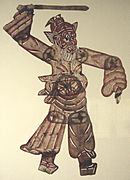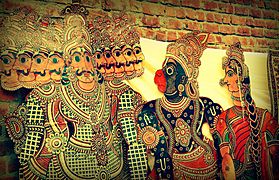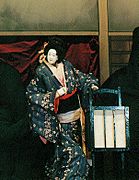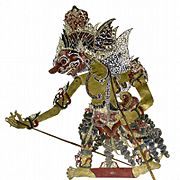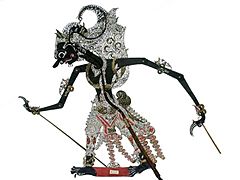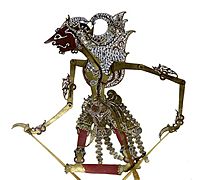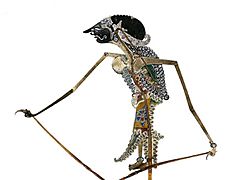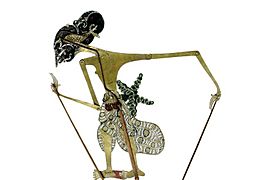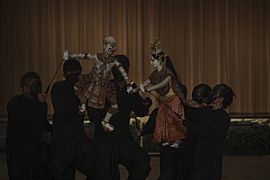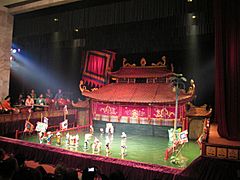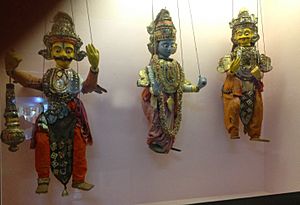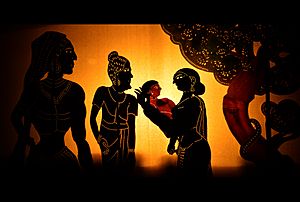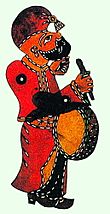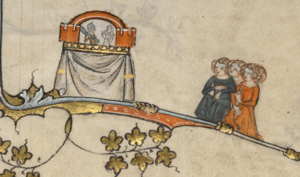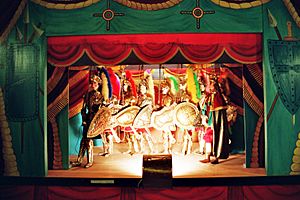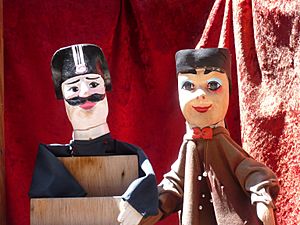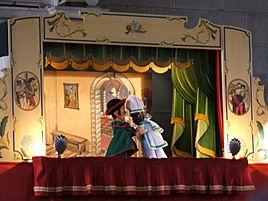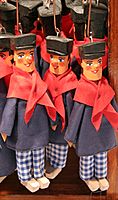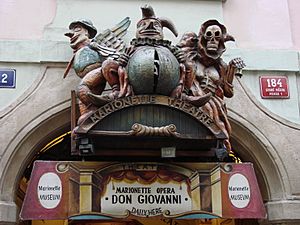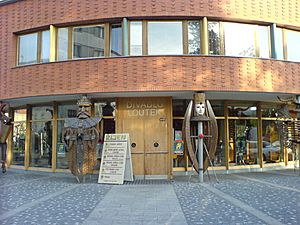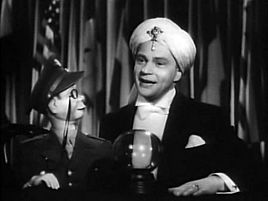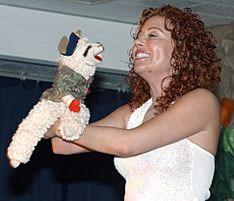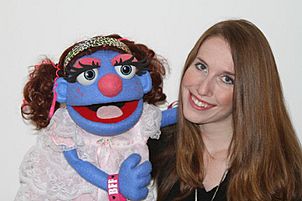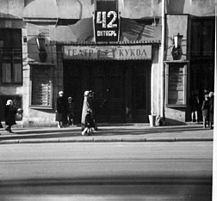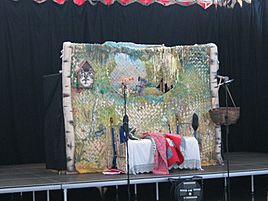Puppetry facts for kids
Quick facts for kids Puppetry |
|
|---|---|
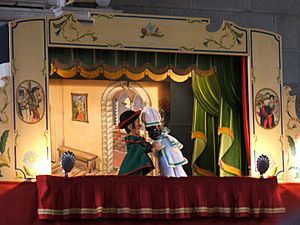
Gioppino and Brighella puppet show in Bergamo, Italy
|
|
| Ancestor arts | Theatre |
| Originating era | 3000 BC |
Puppetry is a special kind of theatre or show. It involves making puppets move. Puppets are objects that look like people or animals. A person called a puppeteer makes them come alive. This type of show is also known as a puppet production. The story for a puppet show is called a puppet play.
Puppeteers use their hands and arms to control the puppets. They might use rods or strings. This helps them move the puppet's body, head, and arms. Sometimes, the puppeteer speaks for the puppet. Other times, they use a recorded voice.
There are many kinds of puppets. They are made from different materials. Some are very simple, like finger puppets. These tiny puppets fit on one finger. Sock puppets are made from a sock. You put your hand inside to make its "mouth" move. A hand puppet or glove puppet is controlled by one hand. Punch and Judy puppets are famous examples.
Some puppets are bigger and need two puppeteers. Japanese Bunraku puppets are like this. Marionettes hang from strings. A puppeteer holds a control bar above them. Rod puppets have a head on a central rod. Their arms are controlled by separate rods. This gives them more ways to move.
Puppetry is a very old art form. It was first written about in Ancient Greece around 500 BC. Some forms might be as old as 3000 BC. All puppetry involves making objects move to tell a story. Puppets are used for fun shows. They are also used in special rituals or celebrations. Sometimes, they help people think about change.
History of Puppets
Puppetry is an ancient art. It is thought to have started about 4000 years ago. Puppets have always helped people share ideas. Some experts believe puppets were used before actors in theatre. In Egypt, around 2000 BCE, wooden figures were moved with strings. They showed actions like kneading bread. Clay and ivory puppets with moving parts were also found in Egyptian tombs. Ancient Egyptian writings mention "walking statues" in religious plays. Puppetry was also popular in ancient Greece. The oldest writings about puppets are from Herodotus and Xenophon in the 5th century BC.
Puppetry in Africa
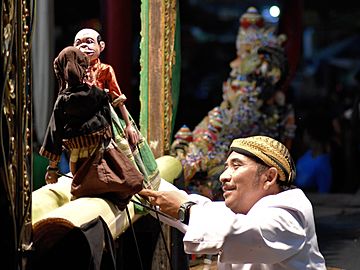
Some puppet traditions in Africa might come from ancient Egypt. Many African groups still use puppets and masks in special ceremonies. They use them for healing and hunting rituals. Today, puppetry is still popular in Africa. It is often part of ceremonies and folk art. This includes dance, storytelling, and masked shows. In rural Africa, puppets still teach cultural values. In big cities, schools and TV now do this.
Puppetry in Asia
East Asia's Puppet Stories
Puppetry existed in the Indus Valley civilization. Archaeologists found a clay doll from 2500 BC. It had a head that could be moved by a string. Another clay monkey could move up and down a stick. Puppets are mentioned in old Indian stories like the Mahabharata. They are also in Tamil literature and other writings from ancient times.
China has a 3000-year history of puppetry. It started with pi-yung xi, or Chinese shadow theatre. By the Song dynasty (960-1279 AD), puppets were popular with everyone. This included the royal courts. However, puppeteers were seen as lower class, like in Europe.
In Taiwan, budaixi puppet shows are popular. They are like Japanese bunraku. Puppeteers work behind or under the stage. Skilled puppeteers can make puppets do amazing stunts. They can even do somersaults in the air.
Japan has many puppet forms. One famous one is bunraku. Bunraku grew from Shinto temple rituals. It became a very complex art. Chikamatsu Monzaemon, a great Japanese writer, wrote only for bunraku. At first, one puppeteer controlled each puppet. By 1730, three puppeteers were used for each puppet. They worked in front of the audience. The puppeteers wore black clothes. They became invisible against a black background. Only the puppets were lit by torches.
Korea's puppet tradition likely came from China. The oldest record of Korean puppetry is from 982 A.D. The Korean word for puppet is Kkoktugakshi. Gagsi means "bride" or "young woman." This was the most common puppet shape. A kkoktugakshi puppet play has eight scenes.
Southeast Asia's Puppet Traditions

The wayang theatre in Indonesia was influenced by Indian traditions. Some experts believe puppets started in India 4000 years ago. The main character in old Indian plays was Sutradhara, meaning "the holder of strings." Wayang is a strong puppet tradition in Indonesia, especially in Java and Bali. In Java, wayang kulit, a detailed shadow puppetry, is very popular. Javanese rod puppets are also old. They tell stories from Javanese history. Another popular puppet form in Indonesia is wayang golek.
Thailand has hun krabok, a popular rod puppet theatre.
Vietnam created water puppetry. This art form is unique to Vietnam. The puppets are made of wood. Shows happen in a waist-high pool of water. Puppeteers use a large rod under the water. This supports and controls the puppets. It makes them look like they are moving on water. This puppetry started seven hundred years ago. Villagers would entertain each other when rice fields flooded. Puppet show contests led to secret puppet groups.
The Philippines developed puppetry during Spanish rule. The oldest Filipino puppetry is carrillo. It was first noted in 1879. It uses small carts for puppet plays. Figures made of cardboard create shadow plays. Later, in the late 1800s, another Filipino puppetry appeared. Higantes are giant papier-mâché puppets. More than a hundred of them are paraded during the Higantes Festival. These puppets honor San Clemente. They also made fun of landowners from colonial times. Many traditions are linked to the higantes. Since the 20th century, many puppet arts have grown in the Philippines. Amelia Lapeña Bonifacio is a famous Filipino puppeteer.
In Myanmar, formerly Burma, a detailed puppet show called Yoke thé developed. It was supported by kings. Burmese marionettes likely started around 1780. This was during King Singu Min's rule. The Minister of Royal Entertainment, U Thaw, is credited with starting it. From the beginning, marionettes were very popular in the courts. Little has changed since U Thaw created the art. The characters he developed are still used today.
-
Wayang Kulit (Shadow Puppet) Kumbakarna, Tropenmuseum Collections, Indonesia, before 1914
-
Wayang Kulit (Shadow Puppet) Gatot Kaca, Tropenmuseum Collections, Indonesia, before 1914
-
Wayang Kulit (Shadow Puppet) Wibisana, Tropenmuseum Collections, Indonesia before 1933
-
Wayang Kulit (Shadow Puppet) Yudhishthira, Tropenmuseum Collections, Indonesia before 1914
-
Wayang Kulit (Shadow Puppet) Princess Tari, Tropenmuseum Collections, Indonesia before 1934
-
Wayang kulit, a puppet-shadow play of Java, Bali, and Lombok from Indonesia
-
Yoke thé puppets, depicting royal patronage, from Myanmar
-
Hun krabok, puppets handled by three performers from Thailand
-
Water puppetry, a unique art originating from Vietnam
Indian Puppet Forms

India has a long history of puppetry. Old Indian stories like the Mahabharata mention puppets. Kathputli, a string puppet show from Rajasthan, is well-known. India also has many ventriloquists and puppeteers. Professor Y. K. Padhye brought ventriloquism to India in the 1920s. His son, Ramdas Padhye, made it even more popular. Almost all types of puppets are found in India.
- String Puppets
India has a rich tradition of string puppets, or marionettes. Marionettes have jointed limbs controlled by strings. This allows them to move very flexibly. Rajasthan, Orissa, Karnataka, and Tamil Nadu are places where this puppetry is strong. Traditional marionettes from Rajasthan are called Kathputli. They are carved from wood and dressed in bright colors. String puppets from Orissa are called Kundhei. In Karnataka, they are Gombeyatta. Puppets from Tamil Nadu, called Bommalattam, use both rod and string puppet methods.
- Shadow Puppets
Shadow puppets are an old part of India's art. They are known by different names in different regions. These include keelu bomme and Tholu bommalata in Andhra Pradesh. Togalu gombeyaata is in Karnataka. Ravana chhaya is in Odisha. Tholpavakoothu is in Kerala. Shadow puppet plays are also seen in Indian paintings. Dance forms like Chhau from Odisha mean "shadow." Shadow theatre shows are often performed on stages near Hindu temples. These stages are called Koothu Madams or Koothambalams. In many areas, traveling artists perform puppet shows. They do this on temporary stages during big temple festivals. Stories from the Hindu epics Ramayana and Mahabharata are common. However, the details of the stories change by region.
In the 19th and early 20th centuries, some thought shadow puppet plays had disappeared in India. But in the 1930s, it was found that they were still strong. They were a lively tradition in rural areas. This included central Kerala, Karnataka, Andhra Pradesh, Tamil Nadu, Odisha, and southern Maharashtra. Marathi people, especially those from lower castes, kept these Hindu epic stories alive. Many puppeteers in non-Marathi states spoke Marathi as their first language. This shows how important Marathi artists were.
According to Beth Osnes, the tholu bommalata shadow puppet theatre is from the 3rd century BCE. It has been supported by many people since then. The puppets for a tholu bommalata show are "see-through, richly colored leather figures." They are four to five feet tall. They have one or two moving arms. Making these puppets is a special ritual. Artist families pray and work alone. Then, they celebrate the "birth of a puppet" with flowers and incense.
The tholu pava koothu of Kerala uses leather puppets. Their images are shown on a screen with light behind it. The shadows create characters and stories from the Ramayana. A full show can take 41 nights. A shorter show can be as quick as seven days. Tholu pava koothu is a team effort by puppeteers. Other shadow plays, like wayang in Indonesia, are done by one puppeteer. There are regional differences in Indian puppet arts. For example, women play a big role in shadow theatre in most of India. But not in Kerala and Maharashtra. Almost everywhere, except Odisha, puppets are made from tanned deer skin. They are painted and have moving parts. See-through leather puppets are common in Andhra Pradesh and Tamil Nadu. Opaque puppets are common in Kerala and Odisha. Artist groups usually carry over a hundred puppets for their shows.
- Rod Puppets
Rod puppets are like glove puppets, but often much bigger. They are held and moved by rods from below. This type of puppetry is now mostly found in West Bengal and Orissa. The traditional rod puppet form of West Bengal is Putul Nautch. They are carved from wood. Their style matches the art of their region. The traditional rod puppet of Bihar is Yampuri.
- Glove Puppets
Glove puppets are also called sleeve, hand, or palm puppets. The head is made of papier mâché, cloth, or wood. Two hands come out from below the neck. The rest of the puppet is a long, flowing skirt. These puppets look soft. But a skilled puppeteer can make them do many movements. The way to move them is simple. The first finger goes into the head. The middle finger and thumb go into the puppet's arms. These three fingers make the glove puppet come alive.
Glove puppets are popular in Uttar Pradesh, Orissa, West Bengal, and Kerala. In Uttar Pradesh, glove puppet plays often show social topics. In Orissa, these plays are based on stories of Radha and Krishna. In Orissa, the puppeteer plays a dholak (hand drum) with one hand. They move the puppet with the other. The talking, puppet movement, and drum beat are all timed together. This creates a dramatic feeling. In Kerala, the traditional glove puppet play is called Pavakoothu.
Puppetry in Afghanistan
Afghanistan has a puppet form called buz-baz. In a show, a puppeteer moves a marionette of a markhor. At the same time, they play a dambura (a long-necked string instrument).
Puppetry in West Asia
Middle Eastern puppetry is shaped by Islamic culture. Karagoz, the Turkish Shadow Theatre, greatly influenced puppetry in this area. It is thought to have come from China, through India. Later, the Mongols took it from the Chinese. They passed it to the Turkish people of Central Asia. The art of Shadow Theater came to Anatolia with Turkish people moving from Central Asia. Others say shadow theatre came to Anatolia from Egypt in the 16th century. They believe it reached the Ottoman palaces when Yavuz Sultan Selim conquered Egypt in 1517. He saw a shadow theatre show and was so impressed. He took the puppeteer back to his palace in Istanbul. His 21-year-old son, later Sultan Suleyman the Magnificent, became interested in the plays.
In other areas, the shadow puppetry style called khayal al-zill still exists. This means "shadows of the imagination." It is a shadow play with live music. It has "drums, tambourines and flutes." It also has "special effects" like smoke, fire, thunder, and rattles. These make the audience laugh or shiver.
In Iran, puppets existed before 1000 AD. But at first, only glove and string puppets were popular. Other types of puppetry appeared during the Qajar dynasty (18th and 19th centuries). This happened as influences from Turkey spread. Kheimeh Shab-Bazi is a traditional Persian puppet show. It is performed in a small room. A musician and a storyteller called a morshed or naghal are part of it. These shows often happen with storytelling in traditional tea and coffee-houses. The morshed talks with the puppets. A recent example of puppetry in Iran is the opera Rostam and Sohrab.
Puppetry in Europe
Ancient Greek and Roman Puppets
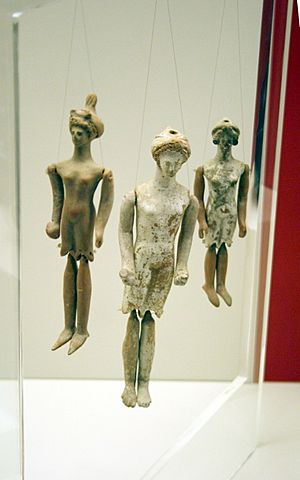
There are not many puppets left from ancient Greece. But old writings and finds show that puppetry existed. The Greek word for "puppet" is "νευρόσπαστος." This means "drawn by strings." Aristotle wrote about pulling strings to move heads, hands, and eyes. Plato also mentioned puppetry. The Iliad and Odyssey were performed with puppets. European puppetry likely started with Greek plays. These plays were for "common people" in the 5th century BC. By the 3rd century BC, these plays were in the Theatre of Dionysus at the Acropolis.
In ancient Greece and ancient Rome, clay dolls were found in children's tombs. Some were made of ivory. They date from around 500 BC. These dolls had moving arms and legs. Some had an iron rod from their heads. This rod was used to move the doll from above. This is still done in Sicilian puppetry today. Some dolls had strings instead of rods. Some researchers think these old figures were just toys, not puppets. This is because of their small size.
Italian Puppet History
- Middle Ages and Renaissance
Many believe Italy is where the marionette began. This is because of Roman puppetry. The Christian church used marionettes for morality plays. The word marionette might come from small figures of the Virgin Mary. So, "marionette" could mean "Mary doll." Comedy was added to the plays over time. This led to the church banning puppetry. Puppeteers then set up stages outside churches. Their shows became even more funny and wild. This led to the Italian comedy called Commedia dell'arte. Puppets were sometimes used in this theatre. Sometimes, Shakespeare's plays were done with marionettes. An early picture of a puppet show is shown here. It is from a Flemish book from 1338 to 1344.
In Sicily, donkey carts have painted scenes from old French poems. These include The Song of Roland. These same stories are performed in traditional puppet theatres. They use handmade wooden marionettes. In Sicilian, this is called "Opera dei pupi". This means "Opera of the puppets." The "Opera dei pupi" and Sicilian storytellers are from the Provençal troubadour tradition. This was in Sicily during the rule of Frederick II, Holy Roman Emperor, in the 13th century.
- 18th and 19th Centuries
The 18th century was important for all Italian theatre. This included marionette theatre. Rod puppets were mostly for the lower class. But marionette theatre was popular with rich people. It was a way to celebrate the Age of Enlightenment. The special effects and complex puppets were very popular. This was especially true in Venice. In the 19th century, Pietro Radillo's marionettes became more complex. Instead of just a rod and two strings, his puppets had up to eight strings. This gave more control over the puppet's body parts.
French Puppets: Guignol
Guignol is the main character in a French puppet show. The show is named after him. People often think it's for kids. But Guignol's sharp humor is also enjoyed by adults. A famous group in Lyon says: "Guignol amuses children… and witty adults." Laurent Mourguet, who created Guignol, had a hard time during the French Revolution. In 1797, he started pulling teeth as a dentist. To get patients, he put on a puppet show in front of his chair.
His first shows had Polichinelle, a character from Italian comedy. By 1804, his shows were so popular he stopped dentistry. He became a full-time puppeteer. He made his own stories based on his working-class audience. He also added jokes about daily news. He created characters like Gnafron, a shoemaker who loved wine. In 1808, he created Guignol. Other characters followed, like Guignol's wife Madelon. But they were mostly there to support the two heroes. Guignol always wins, showing good beating evil.
British Puppetry: Punch and Judy
The traditional British Punch and Judy puppetry started in the 16th century. It comes from Italian comedy. The character "Punch" comes from "Pulcinella." This name became "Punchinello" in English. He is a trickster figure from old myths. Punch's wife was first "Joan," then "Judy." In the late 18th and early 19th centuries, Punch and Judy shows were performed in easy-to-move booths.
In the early 20th century, the British Puppet and Model Theatre Guild helped puppetry grow again. Two founders, H. W. Whanslaw and Waldo Lanchester, wrote books about puppetry. They focused on marionettes. Lanchester had a touring theatre. He also had a permanent place in Malvern, Worcestershire. He often took part in the Malvern Festival. This caught the eye of George Bernard Shaw. One of Shaw's last plays, Shakes versus Shav, was written for Lanchester's company in 1949.
From 1957 to 1969, Gerry Anderson made many TV shows with marionettes. These started with The Adventures of Twizzle and ended with The Secret Service. Many of these shows, like Thunderbirds, used a method called Supermarionation. This automatically matched the puppets' mouth movements to recorded voices. Anderson returned to puppetry in 1983 with Terrahawks.
Today, British puppet theatres include the Little Angel Theatre in London. Also, the Puppet Theatre Barge in London, and the Norwich Puppet Theatre. British puppetry now has many styles. Companies like Horse and Bamboo Theatre use puppetry in visual shows. From 1984 to 1996, puppets were used for political comedy in the TV show Spitting Image. Puppetry also influences mainstream theatre. Recent shows like Warhorse and Madam Butterfly combine puppets with live actors.
Puppets Across Europe
Many versions of Pulcinella appeared as the character spread. In the Netherlands, he is Jan Klaassen. In Denmark, Mester Jackel. In Russia, Petrushka. In Romania, Vasilache. In Russia, the Central Puppet Theatre in Moscow made puppeteers more respected.
Germany and Austria have a long puppet tradition. Much of it comes from Italian comedy of the 16th century. The German version of 'Punch' is Kasperle or Kaspar. Judy is called Grete. In the 18th century, operas were written just for marionette puppets. Famous composers like Gluck and Haydn wrote adult operas for marionettes.
In 1855, Count Franz Pocci started the Munich Marionette Theatre. Pocci, a writer and artist, wrote 40 puppet plays. Albrecht Roser made a big impact with his marionettes in Stuttgart. His characters Clown Gustaf and Grandmother are well-known. Grandmother looks charming, but she makes funny and sharp comments about society.
In Lindau, the Lindau Marionette Opera started in 2000. It was founded by Bernard Leismueller and Ralf Hechelmann. The company performs many operas. They also do a marionette ballet, Swan Lake.
In Augsburg, the historic Augsburg Marionette Theatre began in 1943. It was founded by Walter Oehmichen. It still runs today with a puppet museum. His grandsons, Klaus Marschall and Juergen Marschall, now lead it.
Earlier, in Salzburg, Austria, the Salzburg Marionette Theatre started in 1913. It was founded by Professor Anton Aicher and is famous worldwide. It continues to perform full operas using marionettes. They have their own theatre. It mainly performs operas like Die Fledermaus and The Magic Flute. It also does ballets like The Nutcracker. These shows are for adults, but children are welcome.
There is also a marionette theatre at Schoenbrunn Palace in Vienna. It was founded by Christine Hierzer-Riedler and Werner Hierzer over 40 years ago. This theatre performs famous operas, musicals, and fairy tales.
Czech and Slovak Puppetry
Marionette puppet theatre has a long history in Prague. It also has a long history in the former Czechoslovakia, and now in the Czech Republic and Slovakia. It goes back to the early Middle Ages. Marionettes first appeared around the Thirty Years' War. The first known Czech puppeteer was Jan Jiří Brat, born in 1724. He was a carpenter's son and made his own puppet theatre. Matěj Kopecký was the most famous Czech puppeteer of the 19th century. He helped spread ideas of national pride.
In 1911, Jindřich Veselý helped start the Czech Association of Friends of Puppet Theatre. In 1912, he supported publishing Loutkář. This is the oldest puppet-theatre magazine still published. Veselý was key in starting UNIMA (International Puppetry Association) in 1929. He was its first president.
In 1920 and 1926, Josef Skupa created his famous puppets: Spejbl and Hurvínek. They are a funny father and his mischievous son. In 1930, he opened the first modern professional puppet theatre. The National Marionette Theatre in Prague is an important puppet group. It mainly performs Mozart's opera Don Giovanni with marionettes. The show has old costumes and an 18th-century setting. There are many other companies, like Buchty a Loutky ("Cakes and Puppets"). Puppets have been used a lot in animated films since 1946. Jiří Trnka was a leader in this area. Miroslav Trejtnar is a master puppeteer. He teaches how to make traditional Czech marionettes.
In 2016, Czech and Slovak Puppetry was added to the UNESCO Intangible Cultural Heritage Lists.
19th Century Changes
During the 19th century, puppetry grew separately from actor theatres. Puppeteers performed at fairs and markets. They were often grouped with bandits and gypsies. In the 19th century, puppetry faced competition from other shows. These included vaudeville and music hall. But puppetry adapted. It created stage acts and joined new popular theatre forms. It also found audiences at new seaside resorts.
Puppetry in North America
The Teotihuacan culture (Central Mexico) made figures with moving arms and legs. These were part of their funeral rituals around 600 AD. Native Americans also used ceremonial puppets. In 1519, two puppeteers went with Hernando Cortez to Mexico. Europeans brought their puppet traditions. But over time, unique styles and characters developed in North America.
During the Depression, folk puppeteers traveled with carnivals. They used their own stories and puppets they made themselves.
Some new ideas in 20th-century puppetry came from the United States. Marionette puppetry was used on television in the 1940s. Howdy Doody was a famous marionette on TV. Bil Baird worked to bring marionette theatre back to life in the United States. He and his wife, Cora Eisenberg, had their own marionette theatre in New York. Ventriloquist, Edgar Bergen also made a big impact. In the 1960s, Peter Schumann's Bread and Puppet Theater explored political and artistic ideas with puppets.
Around the same time, Jim Henson created soft puppets. These were made of foam rubber and cloth. They became known as Muppets. First, they were on the children's TV show Sesame Street. Later, they were on The Muppet Show and in movies. They inspired many others. Today, Muppets are known almost everywhere. Henson also started animatronics with his Creature Shop. This was seen in his films The Dark Crystal and Labyrinth. Wayland Flowers also made a big contribution to adult puppetry with his funny puppet, Madame.
Sid and Marty Krofft are famous American puppeteers. They were known for their live-action children's TV shows in the 60s and 70s. These included HR Puffinstuff and Lidsville.
Puppets were also used in the Star Wars films. The character of Yoda was a puppet. Frank Oz provided his voice and movements.
-
Edgar Bergen and his puppet Charlie McCarthy
-
Puppets in the Bread and Puppet Theater Museum in Glover, Vermont, USA
Puppetry in Australia
Aboriginal people have a long history of storytelling. This goes back thousands of years. They used masks and other objects. These showed deep meanings about right and wrong, and nature. Masks were carved from wood and decorated with paint and feathers.
In Australia in the 1960s, Peter Scriven started the Marionette Theatre of Australia. He put on beautiful marionette shows. These included The Tintookies and The Water Babies.
Phillip Edmiston worked with Peter Scriven. In 1977, he created a big marionette show called The Grand Adventure. His company was Theatrestrings. It had 127 marionettes. The show opened in Nambour and toured to Sydney, Melbourne, and Brisbane. The music was by Eric Gross. The story was about Captain James Cook's voyage on HMS Endeavour. Edmiston toured Queensland in the 1980s and 1990s with his new company, Queensland Marionette Theatre.
Bilbar Puppet Theatre was started by Barbara Turnbull and Bill Turnbull. They toured Australia a lot in the 1970s and 1980s. Their shows included The Lucky Charm and Mozart's opera Bastien and Bastienne. Bilbar Puppet Theatre's puppets are now at the Queensland Performing Arts Centre. David Poulton toured marionette shows with his wife Sally. Gwen and Peter Iliffe also toured with Puppet People. Another successful group was Ehmer Puppets.
David Hamilton is one of the last marionette puppeteers in Australia. He tours on his own. Some of his puppets were shown in an exhibition in 2018.
Comedian Jamie Dunn was famous for his Muppet-style character, Agro. Agro was on several TV shows in the 1980s and 1990s.
Brett Hansen and his Larrikin Puppets company are based in Brisbane. He was trained by puppeteers from the Jim Henson Company. His company is one of the few Muppet-style puppeteers in Australia. Cabaret Puppet Theatre, also in Brisbane, tours shows for children and adults.
In Melbourne, Handspan Theatre (1977–2002) grew into a large theatre group. It was known for its 'Visual Theatre'. It became a place for new projects and working with different media.
A post-graduate course in puppetry existed at the Victorian College of the Arts. But it has stopped.
Australian puppeteer Norman Hetherington was famous for his marionette, Mr. Squiggle. He was on an Australian TV show from 1959 to 1999. In each episode, he made pictures from "squiggles" sent by children.
Richard Bradshaw OAM is another famous Australian puppeteer. He is a past president of UNIMA Australia. He also does shadow puppetry and writes about it.
Rod Hull was known for his puppet Emu. In the 1960s, Hull hosted a children's TV show in Australia.
Snuff Puppets is a modern Australian puppet theatre group. They are based in Melbourne. Their shows have dark humor, political jokes, and a handmade look. Snuff Puppets has performed in over 15 countries.
There is an annual winter puppet festival in Melbourne. It happens at ArtPlay and Federation Square.
In Sydney, Jeral Puppets was founded by John and Jackie Lewis in 1966. They perform regularly at Puppeteria Puppet Theatre and on tour.
Spare Parts Puppet Theatre in Fremantle, Western Australia started in 1981. Their first project was a puppet version of Doctor Faustus.
Puppetry Today
From the early 19th century, puppetry started to inspire artists. In 1810, Heinrich von Kleist wrote about the "lack of self-consciousness" of puppets. Puppetry grew in many ways throughout the 20th century. With movies and TV, it now reaches more people than ever. Another change was the idea that puppet theatre could be for adults. It could be experimental and bring new life to actor's theatre.
Sergei Obraztsov explored the idea of kukolnost ('puppetness'). This was despite Joseph Stalin wanting realism. Other pioneers like Edward Gordon Craig and Erwin Piscator were influenced by puppetry. They wanted to refresh mainstream theatre. Writers like Maeterlinck and Shaw wrote puppet plays. Artists like Picasso and Jarry worked in theatre. Craig's idea of the "übermarionette" means treating actors like objects. This has influenced modern "object theatre" and "physical theatre". Tadeusz Kantor often used puppets instead of actors, or combined them. He directed from the stage edge, like a puppeteer.
Kantor influenced new directors like Richard Foreman and Robert Wilson. They focused on the 'object' in theatre. They wanted to "put it on stage and find different ways of looking at it." Innovative puppeteers like Tony Sarg and Jim Henson kept developing puppetry. So, "puppet theatre" is no longer just traditional marionettes or hand puppets. Directors like Peter Schumann of Bread and Puppet Theatre combine masks and puppets. The performer, puppets, and objects are part of a visual theatre. It uses little spoken language.
The Jim Henson Foundation was started by Muppet creator Jim Henson. It is a charity that helps puppetry grow in the United States. It has given many grants to new puppet artists. Puppet groups today, like HomeGrown Theatre in Boise, Idaho, continue the funny and experimental tradition for young adults.
-
The animatronic puppet Little Amal, 2021
Puppetry Events
The International Puppet Festival (PIF) happens every year in mid-September. It takes place in Zagreb, Croatia. It has been held since 1968.
The Puppet Festival Mississauga happens every March. It is in Mississauga, Ontario, Canada. It started in 2020.
Types of Puppets
- Method
- Digital puppetry
- Hand puppet
- Shadow puppetry
- Water puppetry
- By Culture
- Russian puppet theater
- Glove puppetry
See also
 In Spanish: Teatro de títeres para niños
In Spanish: Teatro de títeres para niños
- The Little Marionette Company
- List of highest grossing puppet films
- Pardeh show
- State Puppet Theatre of Fairy Tales
- UNIMA – International Puppetry Association
- World Puppetry Day



